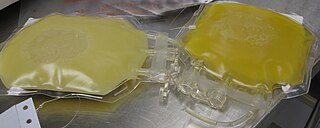Related Research Articles

A carbohydrate is a biomolecule consisting of carbon (C), hydrogen (H) and oxygen (O) atoms, usually with a hydrogen–oxygen atom ratio of 2:1 and thus with the empirical formula Cm(H2O)n, which does not mean the H has covalent bonds with O. However, not all carbohydrates conform to this precise stoichiometric definition, nor are all chemicals that do conform to this definition automatically classified as carbohydrates.

In nutrition, biology, and chemistry, fat usually means any ester of fatty acids, or a mixture of such compounds, most commonly those that occur in living beings or in food.
Vitamin E is a group of eight fat soluble compounds that include four tocopherols and four tocotrienols. Vitamin E deficiency, which is rare and usually due to an underlying problem with digesting dietary fat rather than from a diet low in vitamin E, can cause nerve problems. Vitamin E is a fat-soluble antioxidant which may help protect cell membranes from reactive oxygen species. Worldwide, government organizations recommend adults consume in the range of 3 to 15 mg per day. As of 2016, consumption was below recommendations according to a worldwide summary of more than one hundred studies that reported a median dietary intake of 6.2 mg per day for alpha-tocopherol.

Dietary fiber or roughage is the portion of plant-derived food that cannot be completely broken down by human digestive enzymes. Dietary fibers are diverse in chemical composition, and can be grouped generally by their solubility, viscosity, and fermentability, which affect how fibers are processed in the body. Dietary fiber has two main components: soluble fiber and insoluble fiber, which are components of plant-based foods, such as legumes, whole grains and cereals, vegetables, fruits, and nuts or seeds. A diet high in regular fiber consumption is generally associated with supporting health and lowering the risk of several diseases. Dietary fiber consists of non-starch polysaccharides and other plant components such as cellulose, resistant starch, resistant dextrins, inulin, lignins, chitins, pectins, beta-glucans, and oligosaccharides.

The glycemic (glycaemic) index is a number from 0 to 100 assigned to a food, with pure glucose arbitrarily given the value of 100, which represents the relative rise in the blood glucose level two hours after consuming that food. The GI of a specific food depends primarily on the quantity and type of carbohydrate it contains, but is also affected by the amount of entrapment of the carbohydrate molecules within the food, the fat and protein content of the food, the amount of organic acids in the food, and whether it is cooked and, if so, how it is cooked. GI tables, which list many types of foods and their GIs, are available. A food is considered to have a low GI if it is 55 or less; high GI if 70 or more; and mid-range GI if 56 to 69.

Low-carbohydrate diets restrict carbohydrate consumption relative to the average diet. Foods high in carbohydrates are limited, and replaced with foods containing a higher percentage of fat and protein, as well as low carbohydrate foods.

The Mediterranean diet is a diet inspired by the eating habits and traditional food typical of southern Spain, southern Italy, and Crete, and formulated in the early 1960s. It is distinct from Mediterranean cuisine, which covers the actual cuisines of the Mediterranean countries, and from the Atlantic diet of northwestern Spain and Portugal. While inspired by a specific time and place, the "Mediterranean diet" was later refined based on the results of multiple scientific studies.

Hypercholesterolemia, also called high cholesterol, is the presence of high levels of cholesterol in the blood. It is a form of hyperlipidemia, hyperlipoproteinemia, and dyslipidemia.

Palmitic acid is a fatty acid with a 16-carbon chain. It is the most common saturated fatty acid found in animals, plants and microorganisms. Its chemical formula is CH3(CH2)14COOH, and its C:D ratio is 16:0. It is a major component of palm oil from the fruit of Elaeis guineensis, making up to 44% of total fats. Meats, cheeses, butter, and other dairy products also contain palmitic acid, amounting to 50–60% of total fats.

A plant-based diet is a diet consisting mostly or entirely of plant-based foods. Plant-based diets encompass a wide range of dietary patterns that contain low amounts of animal products and high amounts of fiber-rich plant products such as vegetables, fruits, whole grains, legumes, nuts and seeds. They do not need to be vegan or vegetarian, but are defined in terms of low frequency of animal food consumption.

Vegetarian nutrition is the set of health-related challenges and advantages of vegetarian diets.
The glycemic load (GL) of food is a number that estimates how much the food will raise a person's blood glucose level after it is eaten. One unit of glycemic load approximates the effect of eating one gram of glucose. Glycemic load accounts for how much carbohydrate is in the food and how much each gram of carbohydrate in the food raises blood glucose levels. Glycemic load is based on the glycemic index (GI), and is calculated by multiplying the weight of available carbohydrate in the food (in grams) by the food's glycemic index, and then dividing by 100.

A healthy diet is a diet that maintains or improves overall health. A healthy diet provides the body with essential nutrition: fluid, macronutrients such as protein, micronutrients such as vitamins, and adequate fibre and food energy.
Lauric acid, systematically dodecanoic acid, is a saturated fatty acid with a 12-carbon atom chain, thus having many properties of medium-chain fatty acids. It is a bright white, powdery solid with a faint odor of bay oil or soap. The salts and esters of lauric acid are known as laurates.

Phytosterols are phytosteroids, similar to cholesterol, that serve as structural components of biological membranes of plants. They encompass plant sterols and stanols. More than 250 sterols and related compounds have been identified. Free phytosterols extracted from oils are insoluble in water, relatively insoluble in oil, and soluble in alcohols.

Campesterol is a phytosterol whose chemical structure is similar to that of cholesterol, and is one of the ingredients for E number E499.

Resistant starch (RS) is starch, including its degradation products, that escapes from digestion in the small intestine of healthy individuals. Resistant starch occurs naturally in foods, but it can also be added as part of dried raw foods, or used as an additive in manufactured foods.
A diabetic diet is a diet that is used by people with diabetes mellitus or high blood sugar to minimize symptoms and dangerous complications of long-term elevations in blood sugar.
The Dietary Approaches to Stop Hypertension or the DASH diet is a diet to control hypertension promoted by the U.S.-based National Heart, Lung, and Blood Institute, part of the National Institutes of Health (NIH), an agency of the United States Department of Health and Human Services. The DASH diet is rich in fruits, vegetables, whole grains, and low-fat dairy foods. It includes meat, fish, poultry, nuts, and beans, and is limited in sugar-sweetened foods and beverages, red meat, and added fats. In addition to its effect on blood pressure, it is designed to be a well-balanced approach to eating for the general public. DASH is recommended by the United States Department of Agriculture (USDA) as a healthy eating plan. The DASH diet is one of three healthy diets recommended in the 2015–20 U.S. Dietary Guidelines, which also include the Mediterranean diet and a vegetarian diet. The American Heart Association (AHA) considers the DASH diet "specific and well-documented across age, sex and ethnically diverse groups."
Portfolio Diet is a therapeutic plant-based diet created by Canadian researcher David J. Jenkins in 2003 to lower blood cholesterol. The diet emphasizes using a portfolio of foods or food components that have been found to associate with cholesterol lowering to enhance this effect. Soluble fiber, soy protein, plant sterols, and nuts are the four essential components of Portfolio diet. The diet is low in saturated fat, high in fibre. Researchers have found it has comparable blood cholesterol effect to statin treatment.
References
- ↑ Jenkins, David J.A. "Department of Nutritional Sciences". University of Toronto. Archived from the original on 2009-02-12. Retrieved 2009-01-28.
- ↑ "David J.A. Jenkins, DM DPhil DSc". cdnmedhall.ca. Retrieved 25 January 2024.
- 1 2 "Ask the Expert: The Portfolio Diet By Toby Amidor, MS, RD, CDN". Today's Dietitian Vol. 20, No. 10, P. 10. Retrieved 25 January 2024.
- ↑ "Dr. David Jenkins on The Portfolio Diet and a Glimpse Behind the Scenes of Nutrition Research". everand.com. Retrieved 25 January 2024.
- ↑ "David Jenkins". truehealthinitiative.org. Retrieved 25 January 2024.
- 1 2 "David Jenkins". nutrisci.med.utoronto.ca. Retrieved 25 January 2024.
- ↑ Beck, Leslie (2015-02-23). "Why the man who brought us the glycemic index wants us to go vegan". The Globe and Mail . Retrieved 2015-02-24.
- ↑ Jenkins, DJ; TM Wolever; RH Taylor; H Barker; H Fielden; JM Baldwin; AC Bowling; HC Newman; AL Jenkins; DV Goff (1981). "Glycemic index of foods: a physiological basis for carbohydrate exchange". American Journal of Clinical Nutrition. 34 (3): 362–66. doi: 10.1093/ajcn/34.3.362 . PMID 6259925 . Retrieved 2009-01-28.
- ↑ "Portfolio Diet: Recipe for Lower Cholesterol".
- ↑ Chiavaroli L, Nishi SK, Khan TA, Braunstein CR, Glenn AJ, Mejia SB, Rahelić D, Kahleová H, Salas-Salvadó J, Jenkins DJA, Kendall CWC, Sievenpiper JL. (2018). "Portfolio Dietary Pattern and Cardiovascular Disease: A Systematic Review and Meta-analysis of Controlled Trials". Progress in Cardiovascular Diseases. 61 (1): 43–53. doi: 10.1016/j.pcad.2018.05.004 . PMID 29807048.
{{cite journal}}: CS1 maint: multiple names: authors list (link)